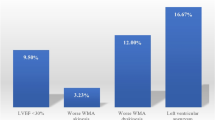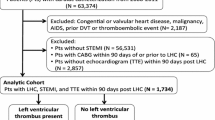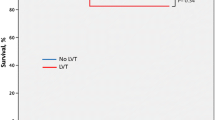Abstract
Previous studies have reported that left ventricular (LV) thrombus is a complication in 10–56% of ST-segment elevation acute anterior wall myocardial infarctions (AWMI). Data suggest that changes in acute myocardial infarction management such as early anticoagulation, thrombolysis, and most recently, primary percutaneous coronary intervention (PCI), may decrease thrombus occurrence. Early time to reperfusion has been shown to decrease mortality and improve LV function recovery. To determine if door-to-balloon time (DTBT) affects the incidence of LV thrombus, we retrospectively analyzed data on 43 consecutive patients who underwent successful PCI of a primary acute ST-segment elevation AWMI. Transthoracic echocardiography was performed for detecting LV thrombus and measuring LV ejection fraction (EF) within 5 days on all patients (average time: 2.17 days post event). Nineteen patients underwent PCI within 2 h of arrival to the Emergency Department (Group A, average 88 min) and 24 patients underwent PCI with DTBT of more than 2 h (Group B, average 193 min). Clinically significant LV thrombus was detected in 35% of all patients. The incidence of LV thrombus formation in Group A was not significantly different from that in Group B (42.1% vs. 29.0%, respectively; P = 0.52). The risk of LV thrombus was independent of in-hospital anticoagulation and medical management, peak enzyme levels, and LVEF but did relate to age (odds ratio = 1.96, 95% CI 1.03–3.73, P = 0.04 per decade). No embolic events in hospital were observed (average hospital stay 9.2 days). We conclude that the incidence of LV thrombus remains high despite PCI. Also, we find that DTBT in patients presenting with an ST-segment elevation AWMI does not affect the incidence of LV thrombus formation. Increased age, however, does appear to increase the risk of LV thrombus development.
Similar content being viewed by others
References
Asinger RW, Mikell FL, Elsperger J, Hodges M (1981) Incidence of left-ventricular thrombosis after acute transmural myocardial infarction. N Engl J Med 305:297–302
Weinreich DJ, Burke JF, Pauletto FJ (1984) Left ventricular thrombi complicating acute myocardial infarction. Long-term follow-up with serial echocardiography. Ann Intern Med 100:789–794
Domemicucci S, Belotti P, Chiarella F, Lupi G, Vecchio C (1987) Spontaneous morphologic changes in left ventricular thrombi: a prospective two-dimensional echocardiographic study. Circulation 75:737–743
Lamas GA, Vaughan DE, Pfeffer MA (1988) Left ventriculcar thrombus formation after first anterior wall acute myocardial infarction. Am J Cardiol 62:31–35
Keren A, Goldberg S, Gottlieb S, et al (1990) Natural history of left ventricular thrombi: their appearance and resolution in the post-hospitalization period of acute myocardial infarction. J Am Coll Cardiol 15:790–800
Keating EC, Gross SA, Schlamowitz RA, et al (1983) Mural thrombi in myocardial infarction: prospective evaluation by two-dimensional echocardiography. Am J Med 74:989–995
Keeley E, Hillis LD (1996) Left ventricular mural thrombus after acute myocardial infarction. Clin Cardiol 19:83–86
Turpie AG, Robinson JG, Doyle DJ, et al (1989) Comparison of high-dose with low-dose subcutaneous heparin to prevent left ventricular mural thrombosis in patients with acute myocardial infarction. N Engl J Med 320:352
Kontny F, Dale J, Abildgaard U, Pedersen TR (1997) Randomized trail of low molecular weight heparin (dalteparin) in prevention of left ventricular thrombus formation and arterial embolism after acute myocardial infarction: The Fragmin in Acute Myocardial Infarction (FRAMI) Study. J Am Coll Cardiol 30:962–969
Vaitkus PT, Barbathan ES (1993) Embolic potential, prevention, and management of mural thrombus complicating anterior myocardial infarction: a meta-analysis. J Am Coll Cardiol 22:1004–1009
Cregler LL (1992) Antithrombotic therapy in the left ventricular thrombosis and systemic embolism. Am Heart J 123:1110–1114
Mooe T, Teien D, Karp K, Eriksson P (1995) Left ventricular thrombosis after anterior myocardial infarction with and without thrombolytis therapy. J Intern Med 237:563–569
Pizzetti G, Belotti G, Margonato A, et al (1996) Thrombolytic therapy reduces the incidence of left ventricular thrombus after anterior myocardial infarction Relationship to vessel patency and infarct size. Eur Heart J 17:421–426
Greaves S, Zhi G, Lee RT, et al (1997) Incidence and natural history of left ventricular thrombus following anterior wall acute myocardial infarction. Am J Cardiol 80:442–448
Chiarella F, Santoro E, Domeniccuci S, Maggioni A, Vecchio C (1998) Predischarge two-dimensional echocardiography evaluation of left ventricular thrombosis after acute myocardial infarction in the GISSI-3 study. Am J Cardiol 81:822–827
Domenicucci S, Chiarella F, Bellotti P, Belline P, Lupi G, Vecchio C (1999) Long term prospective assessment of left ventricular thrombus in anterior wall myocardial infarction and implications for a rational approach to embolic risk. Am J Cardiol 83:519–524
Ileri M, Tadogan I, Kosar F, Yetkin E, Buyukasik Y, Kutuk E (1999) Influence of thrombolytic therapy in the incidence of left ventricular thrombi after acute anterior myocardial infarction: role of successful reperfusion. Clin Cardiol 22:477–480
Kalra A, Jang IK (2000) Prevalence of early left ventricular thrombus after primary coronary intervention for acute myocardial infarction. J Thromb Thrombolysis 10:133–136
Nayak D, Aronow WS, Sukhija R, McClung JA, Monsen CE, Belkin RN (2004) Comparison of frequency of left ventricular thrombi in patients with anterior wall versus non-anterior wall acute myocardial infarction treated with antithrombotic and antiplatelet therapy with and without coronary revascularization. Am J Cardiol 93:1529–1530
Cannon CP, Gibson CM, Lambrew CT, et al (2000) Relationship of symptom-onset-to-balloon time and door-to-balloon time with mortality in patients undergoing angioplasty for acute myocardial infarction. JAMA 283:2941–2947
Berger P, Ellis SG, Holmes DR Jr et al (1999) Relationship between delay in performing direct coronary angioplasty and early clinical outcomes in patients with acute Myocardial infarction (GUSTO-IIb). Circulation 100:14–20
Juliard JM, Feldman LJ, Golmard JL et al (2003) Relation of mortality of primary angioplasty during acute myocardial infarction to door-to-Thrombolysis in Myocardial Infarction (TIMI) time. Am J Cardiol 91:1401–1405
Sheiban I, Fragasso G, Rosana GM et al (2001) Time course and determinants of left ventricular function recovery after primary angioplasty in patients with acute myocardial infarction. J Am Coll Cardiol 38:464–471
Visser CA, Kan G, Meltzer RS, Dunning AJ, Roelandt J (1985) Embolic potential of left ventricular thrombus after myocardial infarction: a two-dimensional echocardiographic study of 119 patients. J Am Coll Cardiol 5:1276–1280
De Luca G, Suryapranata H, Zijlstra F et al (2003) Symptom-onset-to-balloon time and mortality in patients with acute myocardial infarction treated by primary angioplasty. J Am Coll Cardiol 42:991–997
Rao AC, Collinson PO, Canepa-Anson R, Joseph SP Troponin (1998) T measurements after myocardial infarction can identify left ventricular ejection of less that 40%. Heart 80:223–225
Panteghini M, Cuccia C, Bonnetti G et al (2002) Single point cardiac troponin T at coronary care unit discharge after myocardial infarction correlates with infarct size and ejection fraction. Clin Chem 48:1432–1436
Solomon SD, Glynn RJ, Greaves S et al (2001) Recovery of ventricular function after myocardial infarction in the reperfusion era: the healing and early afterload reducing therapy study. Ann Intern Med 134(6):451–458
Anzia T, Yoshikawa T, Kaneko H et al (2004) Association between serum C-reactive protein elevation and left ventricular thrombus formation after first anterior myocardial infarction. Chest 125:384–389
Lesnefsky EJ, Lundergan CF, Hodgson JM et al (1996) Increased left ventricular dysfunction in elderly patients despite successful thrombolysis: the GUSTO-1 angiographic experience. J Am Coll Cardiol 28(2):331–337
Grosso MA, Banerjee A, St Cyr JA et al (1992) Cardiac 5′-nucleotidase activity increases with age and inversely relates to recovery from ischemia. J Thorac Cardiovasc Surg 103(2):206–209
Author information
Authors and Affiliations
Corresponding author
Rights and permissions
About this article
Cite this article
Rabbani, L.E., Waksmonski, C., Iqbal, S.N. et al. Determinants of left ventricular thrombus formation after primary percutaneous coronary intervention for anterior wall myocardial infarction. J Thromb Thrombolysis 25, 141–145 (2008). https://doi.org/10.1007/s11239-007-0064-2
Received:
Accepted:
Published:
Issue Date:
DOI: https://doi.org/10.1007/s11239-007-0064-2




